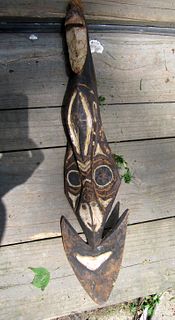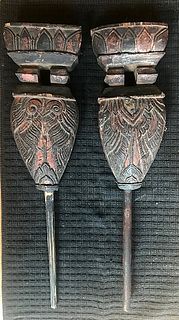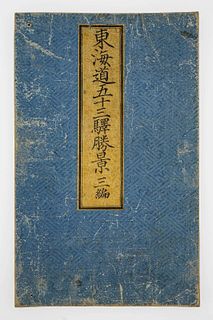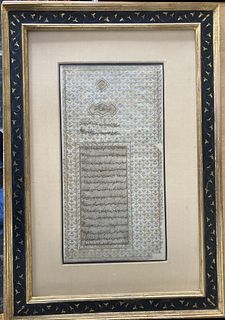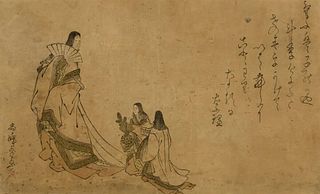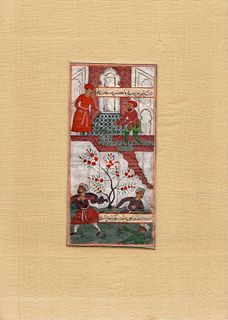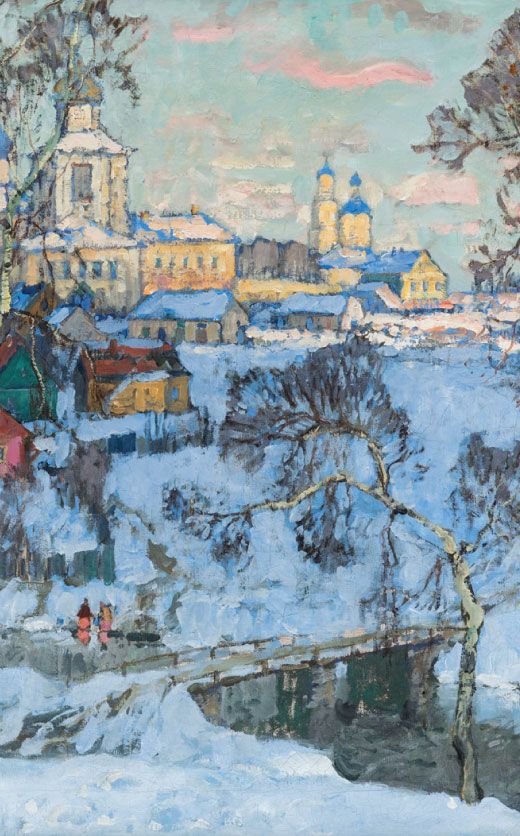Large 19th C. Chinese Wood Nanhai Guanyin in Grotto
Lot 1b
About Seller
Artemis Fine Arts
686 S Taylor Ave, Ste 106
Louisville, CO 80027
United States
Selling antiquities, ancient and ethnographic art online since 1993, Artemis Gallery specializes in Classical Antiquities (Egyptian, Greek, Roman, Near Eastern), Asian, Pre-Columbian, African / Tribal / Oceanographic art. Our extensive inventory includes pottery, stone, metal, wood, glass and textil...Read more
Categories
Estimate:
$17,000 - $25,500
Absentee vs Live bid
Two ways to bid:
- Leave a max absentee bid and the platform will bid on your behalf up to your maximum bid during the live auction.
- Bid live during the auction and your bids will be submitted real-time to the auctioneer.
Bid Increments
| Price | Bid Increment |
|---|---|
| $1 | $25 |
About Auction
By Artemis Fine Arts
May 1, 2025
Set Reminder
2025-05-01 10:00:00
2025-05-01 10:00:00
America/New_York
Bidsquare
Bidsquare : Fine Antiquities, Asian, Ethno, Fine Art
https://www.bidsquare.com/auctions/artemis-gallery/fine-antiquities-asian-ethno-fine-art-19334
Showcasing an extraordinary array of artifacts and art, including Egyptian, Greek, Roman, Etruscan, Near Eastern, Asian, Pre-Columbian, Native American, Tribal, Oceanic, Spanish Colonial treasures, fossils, fine and visual arts, and more! All ancient items are ethically sourced and legally available for sale. Enjoy the ease of in-house shipping for a seamless experience! Artemis Fine Arts info@artemisfinearts.com
Showcasing an extraordinary array of artifacts and art, including Egyptian, Greek, Roman, Etruscan, Near Eastern, Asian, Pre-Columbian, Native American, Tribal, Oceanic, Spanish Colonial treasures, fossils, fine and visual arts, and more! All ancient items are ethically sourced and legally available for sale. Enjoy the ease of in-house shipping for a seamless experience! Artemis Fine Arts info@artemisfinearts.com
- Lot Description
East Asia, China, Qing Dynasty, ca. 1801 CE. Within the sculpted embrace of her island grotto on Mount Putuo, this painted wooden sculpture unveils Nanhai Guanyin, the compassionate Bodhisattva of the Southern Seas, gracefully seated in lalitasana upon a lotus throne. Faint whispers of gold still cling to her regal crown, a testament to past reverence, while her serene countenance gazes outward from beneath the cave's sculpted overhang. Her left hand gently rests upon sacred sutras, a source of boundless wisdom, as her right hand forms the apana mudra, a gesture of grounding and release. A once-vibrant parrot, often symbolizing auspiciousness, perches nearby, and a vase, embodying purity and the nectar of compassion, stands as silent companions in her tranquil abode. Above, the Monkey King is also visible. Consecrated by an open cavity on its verso, this piece bears an inscription that speaks to its creation in the year 1801, serving as a potent emblem of Guanyin's boundless mercy, extending solace and enlightenment like the endless tides of the southern seas. Size: 12.7" L x 18.5" W x 46.4" H (32.3 cm x 47 cm x 117.9 cm)
A distinct and deeply revered form of the Bodhisattva Avalokitesvara in Chinese Buddhism is Nanhai Guanyin, the Guanyin of the Southern Seas. This manifestation holds particular significance as the protector of those whose lives and livelihoods are connected to the ocean's expanse, including sailors and fishermen. Frequently portrayed dwelling in a seaside grotto on Mount Putuo, one of China's four sacred Buddhist mountains, she embodies boundless compassion specifically directed towards those navigating the challenges of the sea. This unique iconography and strong regional association underscore the remarkable adaptability of Buddhist deities within Chinese culture. Guanyin's universal mercy, in the guise of Nanhai Guanyin, becomes a tangible symbol of hope and aid for maritime communities, offering solace amidst the unpredictable and often perilous nature of the ocean.
The Monkey King, a central figure in Chinese mythology and the epic Journey to the West, is a powerful and mischievous character. Guanyin, the Bodhisattva of Compassion, plays a crucial role in his story. She subdues him after his rebellion against heaven and later guides him on a pilgrimage to retrieve Buddhist scriptures. Artistic depictions of the pair often highlight this complex relationship. Guanyin is frequently shown as a serene and authoritative figure, while the Monkey King is portrayed with dynamic energy, sometimes mischievous and sometimes reverent. These depictions emphasize themes of control, guidance, and redemption, reflecting the transformative power of Buddhist teachings on even the most unruly of beings.
A tale, which first appeared in the Ming dynasty, recounts how a parrot became a disciple of Guanyin. Set during the Tang dynasty, the story centers on a family of white parrots residing in a tree. One young parrot demonstrates exceptional intelligence, capable of reciting sutras, chanting Amitabha's name, and, in some accounts, even composing poetry. One day, the father parrot is killed by hunters, and when the mother parrot investigates, she is blinded by the same hunters. The intelligent young parrot sets out to find cherries (sometimes specified as lychees) to feed his mother, but is captured by these same hunters. By the time the parrot escapes, his mother has died. After mourning her death and providing a proper funeral, the Earth God suggests that the parrot venerate Guanyin. Moved by the parrot's extraordinary filial piety, Guanyin allows its parents to be reborn in the Pure Land. This story was initially told in the Tale of the Filial Parrot and later retold in the Precious Scroll of the Parrot. In popular depictions, the parrot is white and typically shown near Guanyin's right side, holding either a pearl or a prayer bead in its beak, and became a symbol of filial piety.
Historically, carved figural statues held profound cultural and religious significance in China, serving not merely as decoration but as vital conduits for spiritual inspiration, solace, and ancestral veneration. These sacred objects populated homes, clan halls, temples, and public spaces, where altars and shrines honored familial ancestors and a pantheon of deities. The size and opulence of these dedicated spaces reflected a family's standing, with even modest homes featuring altars for expressing Confucian piety through ancestor worship. Wealthier families often dedicated entire rooms to elaborate shrines, housing images and ancestor tablets – inscribed placards acting as spiritual seats for the deceased, sometimes even found in temple halls where monks offered prayers for their well-being in the afterlife.
Central to imbuing these carvings with spiritual potency was the "eye opening ceremony," a consecration ritual performed by a senior priest or monk. This process, involving practices like dotting the eyes with cinnabar, pricking them, or anointing them with liquids, was believed to awaken the statue's senses, enabling it to perceive and respond to devotees' prayers. Before this ritual, a cavity carved into the statue's back was filled with sacred documents, a dated paper script honoring the donors and commemorating the event, prayers, and symbolic items representing inner organs, then sealed. The completed, veiled statue was then solemnly carried to the temple for the complex consecration, a communal event believed to imbue the inert carving with life force (chi or qi) and invite the deity's spirit to reside within.
Provenance: private Los Angeles, California, USA collection, acquired from 1990 - 2005
All items legal to buy/sell under U.S. Statute covering cultural patrimony Code 2600, CHAPTER 14, and are guaranteed to be as described or your money back.
A Certificate of Authenticity will accompany all winning bids.
We ship worldwide and handle all shipping in-house for your convenience.
SHIPPING EXCEPTIONS: Due to customs clearance issues, we are unable to ship to Germany, Switzerland and Australia. If you live in Germany, Switzerland or Australia, you will need to provide an alternate shipping destination, or we will not be able to complete your purchase. In addition, please note that we are unable to ship ancient items back to the original country of origin (Egyptian to Egypt, Greek to Greece, etc.)
PAYMENT EXCEPTION: Unless a known customer of Artemis, payment for all gold / precious metal / gem lots must be made via Bank Wire Transfer or Certified Bank Check/Money Order, no exceptions.
#193630Missing cover of consecrated niche in verso, as well as contents. Stable fissures, chipping, nicks, and abrasions to surface. Otherwise, impressive presentation and mostly intact with liberal remains of pigment and trace remains of gilding. Rich patina throughout.Condition
- Shipping Info
-
All shipping is handled in-house for your convenience. Your invoice from Artemis Gallery will include shipping calculation instructions. If in doubt, please inquire BEFORE bidding for estimated shipping costs for individual items.
-
- Buyer's Premium



 EUR
EUR CAD
CAD AUD
AUD GBP
GBP MXN
MXN HKD
HKD CNY
CNY MYR
MYR SEK
SEK SGD
SGD CHF
CHF THB
THB









